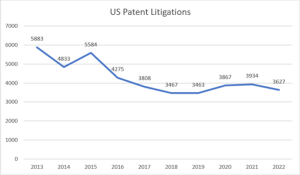In the ever-evolving landscape of intellectual property (IP), the enforcement of patent rights through litigation, known as patent assertion, has become a topic of both significance and controversy. While patent litigation serves as a crucial tool for protecting inventions and monetizing intellectual property, it has also raised concerns due to its association with entities often referred to as “patent trolls.” These entities, known formally as Patent Assertion Entities (PAEs) or Non-Practicing Entities (NPEs), acquire patents with the primary intention of asserting them against other companies rather than actively using or licensing the technology. This phenomenon has led to debates surrounding the balance between protecting IP rights and fostering innovation.
Understanding Patent Assertion and Litigation Dynamics
At its core, patent litigation involves the legal process of validating a patent’s legitimacy and asserting that another party is infringing on the patent owner’s rights. It is a widely employed strategy by patent holders to protect their intellectual property and ensure they can reap the benefits of their innovations. Through licensing agreements, patent holders can grant third parties the right to use their patented technology in exchange for compensation, thereby generating revenue while still promoting innovation and access to valuable technology.
However, the rise of patent trolls has complicated the landscape of patent assertion. These entities often acquire patents with no intention of using them for innovation but rather to extract settlements or licensing fees from other companies. While they argue that they play a role in the market by enforcing patent rights, critics contend that their actions stifle innovation and create unnecessary legal hurdles for businesses. Balancing the interests of patent holders with the need to prevent abuse of the patent system is a challenge that policymakers and businesses alike continue to grapple with.
Unraveling the Phenomenon of Patent Trolls: Myth or Reality?
Over time, patent assertion has sparked controversy, particularly due to its association with “patent trolls,” entities that acquire patents with the intent of asserting them against alleged infringers instead of utilizing or licensing the technology. While criticized for potentially hindering innovation, these entities continue to dominate the landscape of patent litigation.
Despite differing opinions, patent litigation remains an integral part of the patent system, serving both protective and contentious purposes. Striking a balance between the rights of patent holders and the imperative of fostering innovation and competition is essential.
Trends in US Patent Litigation
In recent years, the frequency of patent assertion cases in US courts has exhibited stability. Figure 1 illustrates the trend in US patent litigations since 2013. Apart from notable spikes during the enactment of the America Invents Act in 2012 and Apple’s triumph over Samsung with a $1 billion verdict, there has been minimal fluctuation in activity. However, there was a notable uptick of 12-13% in patent assertion cases in 2020 and 2021 compared to the preceding years, potentially attributed to the COVID-19 pandemic. This surge suggests an increased inclination among companies to capitalize on their patents during this period.
Understanding Product Vulnerability to Patent Assertion
No product or feature is immune to the risk of patent assertion, regardless of the size or industry of the company behind it. Startups, in particular, face significant challenges when confronted with patent litigation due to limited resources and the potential for lengthy legal battles.
Products with high sales and revenue figures are particularly susceptible to patent assertion, as courts often base damage calculations on product sales. Consequently, it is essential for companies to conduct thorough evaluations of potential IP infringement risks before launching new products or features.
The Impact: Assessing the Fallout of Patent Assertion
The consequences of patent assertion extend far beyond the courtroom, impacting companies in various ways. Legal battles can tarnish a company’s reputation and erode consumer trust, leading to potential damage to brand image and market competitiveness. Moreover, the financial strain imposed by licensing fees and legal expenses can hinder investment in innovation and growth opportunities, even if the company successfully defends against patent assertion.
The repercussions of patent assertion extend beyond legal battles, affecting companies’ reputations, market competitiveness, and financial stability. Negative publicity stemming from litigation can tarnish a company’s image, while legal entanglements divert resources from core business activities, hampering market competitiveness and hindering financial growth.
Mitigating Risk: Strategies for Success
Despite the challenges posed by patent assertion, companies can employ various strategies to mitigate the associated risks and protect their intellectual property. Conducting comprehensive patent searches before product development can help identify potential infringement issues early on, allowing companies to make informed decisions about their technology and mitigate legal risks. Seeking licensing agreements with patent holders can provide a pathway for using patented technology while avoiding costly litigation.
Innovation around existing patents may also be a viable option for companies looking to develop products or features that avoid infringement. Additionally, obtaining freedom-to-operate opinions from patent attorneys and seeking legal advice when unsure about infringement risks can provide valuable guidance and insight into navigating the complex landscape of patent assertion.
Conclusion
In conclusion, patent assertion is a fundamental aspect of protecting intellectual property rights and promoting innovation. However, the presence of patent trolls presents challenges that must be addressed to ensure a fair and balanced patent system. By implementing proactive strategies to mitigate the risks associated with patent assertion, companies can safeguard their innovations and thrive in competitive markets. Balancing the interests of patent holders with the broader goals of promoting innovation and competition is essential for fostering a vibrant and dynamic intellectual property ecosystem.
The Silver Bullet Invalidity Search offers specialized expertise in crafting patent counter-assertion strategies tailored to individual needs. Our team of seasoned patent professionals is adept at evaluating infringement concerns and adeptly navigating negotiations toward favourable resolutions. For further details, please explore our patent invalidity service pages.


